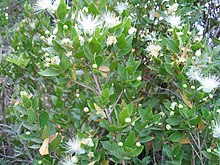Myrtaceae
| Myrtle family | |
|---|---|
 |
|
| Myrtus communis foliage and flowers | |
| Scientific classification | |
| Kingdom: | Plantae |
| (unranked): | Angiosperms |
| (unranked): | Eudicots |
| (unranked): | Rosids |
| Order: | Myrtales |
| Family: |
Myrtaceae Juss. |
| Genera | |
|
About 130; see list |
|
About 130; see list
Myrtaceae is the myrtle family, a family of dicotyledonous plants placed within the order Myrtales. Myrtle, pohutukawa, the bay rum tree, clove, guava, acca (feijoa), allspice, and eucalyptus all are members of this group. All species are woody, with essential oils, and flower parts in multiples of four or five. One notable character of the family is that the phloem is located on both sides of the xylem, not just outside as in most other plants. The leaves are evergreen, alternate to mostly opposite, simple, and usually with an entire (not toothed) margin. The flowers have a base number of five petals, though in several genera the petals are minute or absent. The stamens are usually very conspicuous, brightly coloured and numerous.
Recent estimates suggest the Myrtaceae include approximately 5950 species in ca 132 genera. The family has a wide distribution in tropical and warm-temperate regions of the world, and are typically common in many of the world's biodiversity hotspots. Genera with capsular fruits such as Eucalyptus, Corymbia, Angophora, Leptospermum, and Melaleuca are absent from the Americas, apart from Metrosideros in Chile and Argentina. Genera with fleshy fruits have their greatest concentrations in eastern Australia and Malesia (the Australasia ecozone) and the Neotropics. Eucalyptus is a dominant, nearly ubiquitous genus in the more mesic parts of Australia and extends north sporadically to the Philippines. Eucalyptus regnans is the tallest flowering plant in the world. Other important Australian genera are Callistemon (bottlebrushes), Syzygium, and Melaleuca (paperbarks). Species of the genus Osbornia, native to Australasia, are mangroves. Eugenia, Myrcia, and Calyptranthes are among the larger genera in the neotropics.
...
Wikipedia
